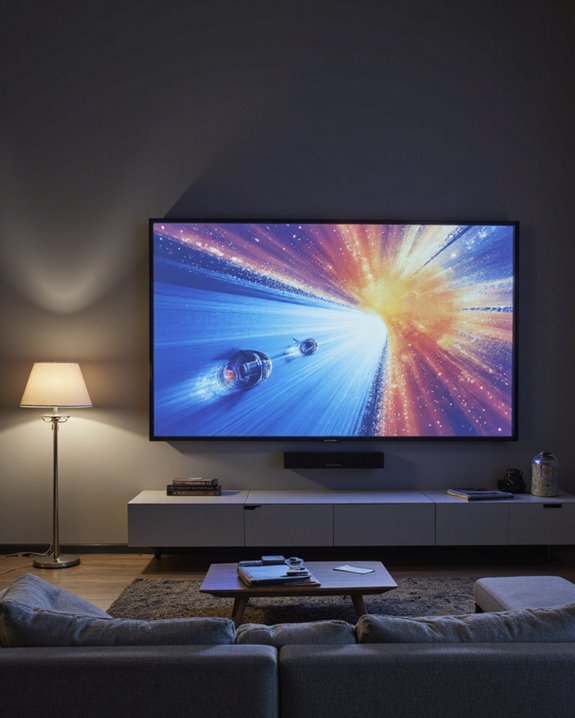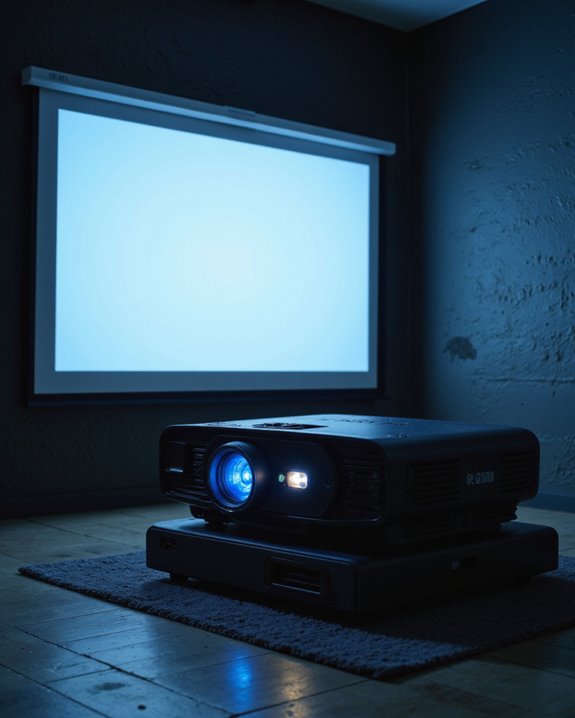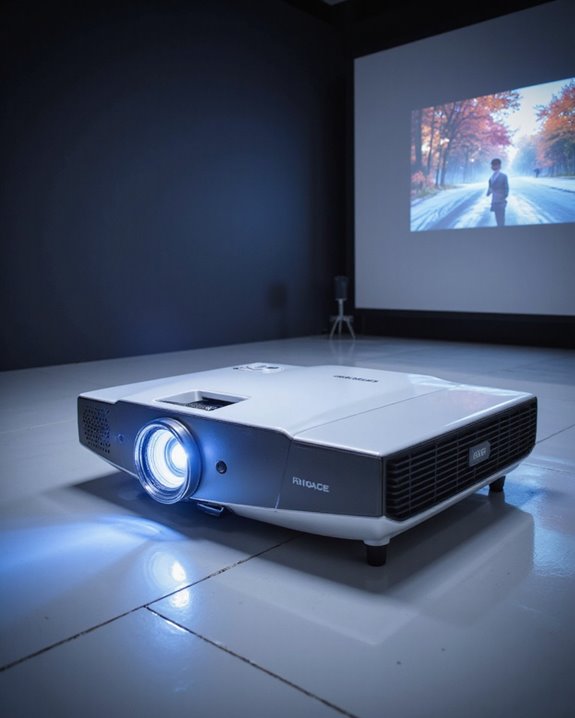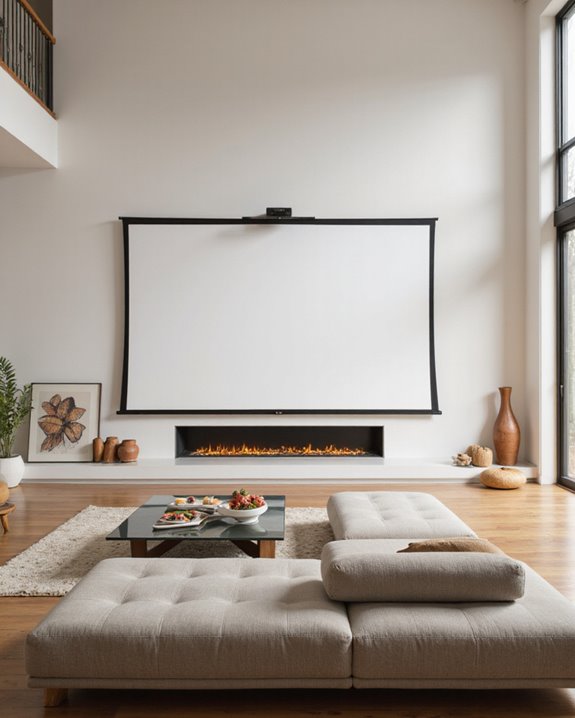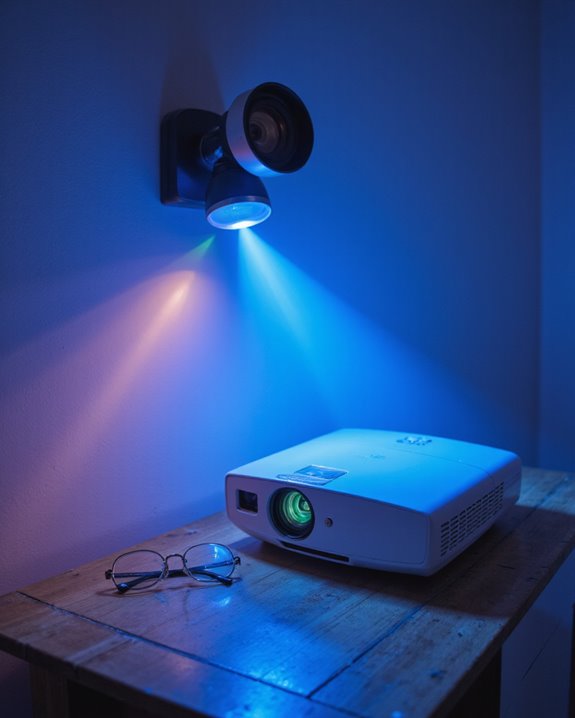Projectors can effectively work on grey walls, offering enhanced contrast and better black levels compared to white surfaces. Grey walls naturally reduce ambient light reflection, making them suitable for rooms with varying lighting conditions. While they provide a cost-effective alternative to professional screens, image quality may be affected by wall texture and surface irregularities. Proper setup, calibration, and wall preparation are essential for ideal results, though certain limitations should be considered before committing to this solution.
Key Takeaways
- Yes, projectors work effectively on grey walls, offering improved contrast and black levels compared to white surfaces, with gain values around 0.8-1.0.
- Grey walls reflect less ambient light than white surfaces, making them suitable for rooms where complete darkness isn’t possible.
- Wall texture and surface imperfections can affect image quality, so proper wall preparation and smoothing is essential.
- Colors may appear slightly muted on grey walls, requiring projector calibration adjustments for optimal image quality.
- Grey walls are a cost-effective alternative to dedicated screens, though they may not match professional screens’ performance.
Understanding Grey Walls as Projection Surfaces
Grey walls serve as an alternative projection surface to dedicated screens, offering distinct advantages and limitations for home theater enthusiasts. These surfaces typically provide a gain value between 0.8 and 1.0, which helps enhance image contrast and black levels when compared to white walls. For optimal viewing experiences, projection surfaces should feature an extra wide viewing cone that accommodates multiple viewing positions.
The surface texture of grey walls presents a key consideration for projection quality. Unlike specialized screens, standard wall surfaces tend to be less smooth, which can impact image sharpness and color accuracy. However, grey walls offer practical benefits in managing ambient light, as they reflect less light than white surfaces while maintaining better visibility than black ones. This makes them suitable for rooms with moderate lighting conditions. The wall’s material composition, typically painted drywall, lacks the specialized coatings found in professional projection screens but remains a viable option for casual viewing setups. Additionally, understanding the gain value of the wall surface is important, as it influences brightness and contrast levels for your projected image.
Impact of Grey Walls on Image Quality
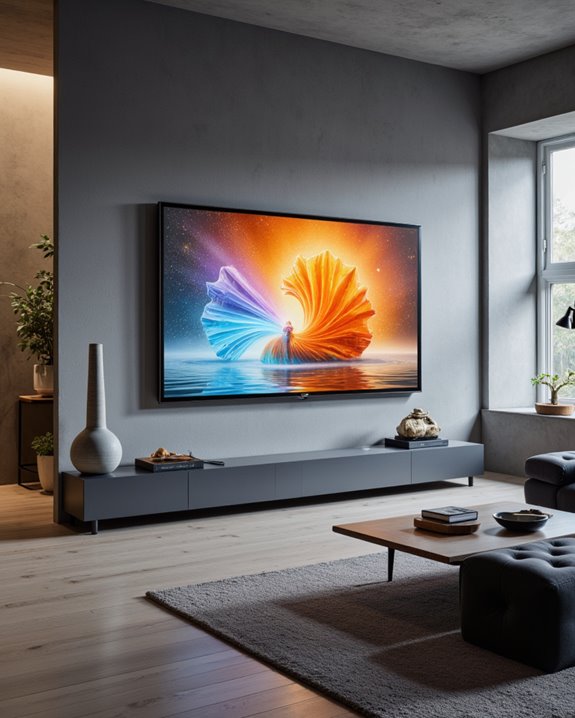
Projecting images onto grey surfaces considerably impacts the overall viewing experience, affecting everything from contrast ratios to color reproduction. While grey walls enhance contrast by reducing ambient light reflections, they present both advantages and challenges for image quality.
The grey surface effectively improves black levels and contrast, similar to specialized grey projection screens. The surface material provides effective ambient light rejection, making it particularly suitable for rooms with varying lighting conditions. Additionally, grey surfaces can help mitigate some issues related to light bleed, which can be problematic in less controlled lighting environments. However, this benefit comes with potential trade-offs in color fidelity, as the grey tint can cause colors to appear slightly muted. The viewing angle may also be narrower compared to white surfaces, affecting image visibility for viewers seated at extreme angles.
The success of grey wall projection largely depends on proper projector selection and calibration. Higher-brightness projectors can help compensate for the reduced reflectivity of grey surfaces, ensuring suitable image quality despite the darker projection surface.
Key Benefits of Projecting on Grey Walls
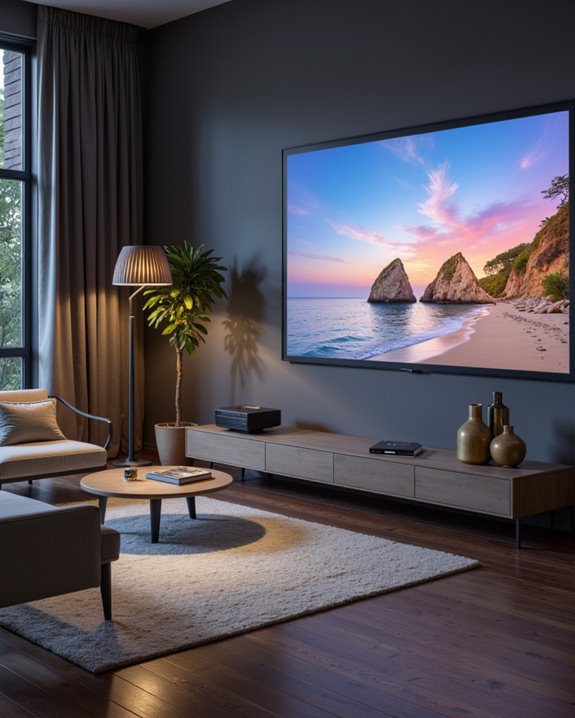
The decision to project onto grey walls offers five notable advantages that benefit both residential and professional environments. The enhanced contrast capability of grey surfaces markedly improves color accuracy and image clarity, especially in rooms with ambient light. Material durability makes grey walls a long-lasting solution that requires minimal maintenance while reducing operational costs. The high-quality sharp image projection capabilities make it an ideal choice for professional presentations and entertainment purposes. Additionally, the ambient light reduction properties of grey walls help maintain consistent image quality across various lighting conditions. Grey walls provide substantial space efficiency by eliminating the need for separate projection screens, while also offering versatility in content presentation. The surface’s ability to absorb ambient light reduces washout effects, making images more vibrant and visible. From a financial perspective, painting a wall grey proves more cost-effective than purchasing traditional projection screens. Additionally, the eco-friendly nature of this setup contributes to lower energy consumption, supporting both environmental initiatives and reduced utility costs.
Common Challenges When Using Grey Walls
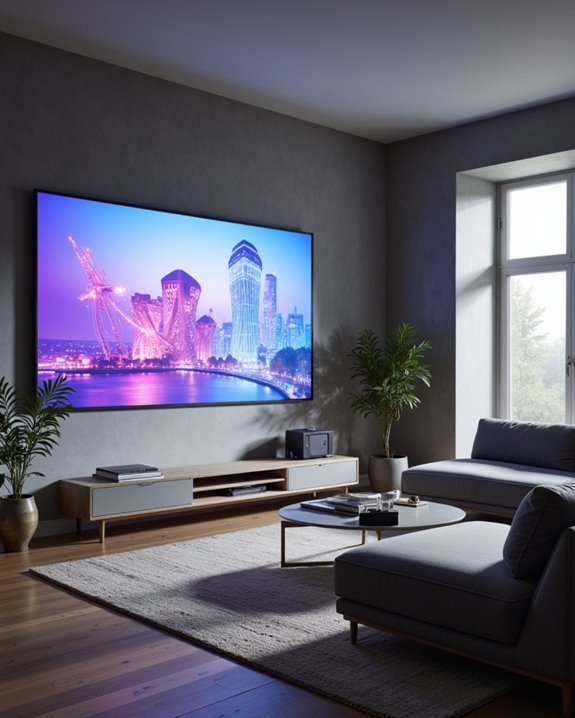
While projecting onto grey walls offers distinct advantages, users frequently encounter several technical hurdles that can impact image quality and viewing experience. Surface texture irregularities and uneven wall color consistency often result in distorted images, reduced sharpness, and compromised color accuracy. Regular inspection and cleaning of the projection surface is crucial since dust accumulation can significantly degrade image quality.
The material durability of grey walls presents ongoing challenges, as surface imperfections and accumulated dirt can create visual artifacts and blotches in the projected image. Additional concerns include:
- Diminished brightness and contrast compared to specialized screens
- Poor ambient light rejection, leading to washed-out images
- Limited viewing angles that affect image clarity
- Difficulty maintaining consistent color calibration
- Surface texture issues that impair high-resolution content display
These challenges typically require users to make significant adjustments to projector settings and carefully control room lighting conditions for optimal results.
Essential Adjustments for Grey Wall Projection
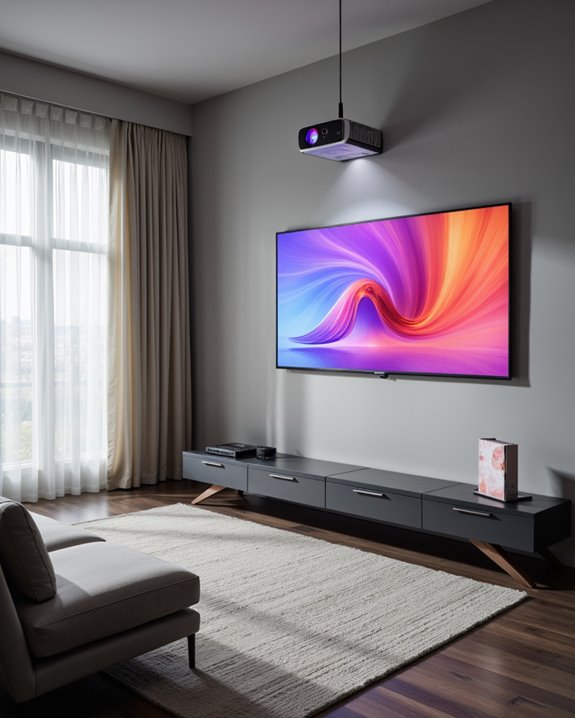
Successful grey wall projection requires precise adjustments to both equipment settings and environmental factors for ideal image quality. Color calibration plays a vital role, with projector settings needing careful adjustment to compensate for the grey surface’s light absorption properties. Users should first minimize ambient lighting in the room to enhance image contrast and visibility. Focus wheel adjustment is essential to ensure maximum image sharpness on grey surfaces.
The most effective adjustments include increasing the projector’s brightness level and contrast ratio to counteract the grey wall’s dampening effect. Proper positioning of the projector ensures ideal image alignment and reduces distortion. For best results, users should:
- Adjust color temperature based on content type
- Use keystone correction to maintain image shape
- Fine-tune gamma settings for better detail visibility
- Consider applying projection-friendly paint to improve reflectivity
Comparing Grey Walls to Professional Screens
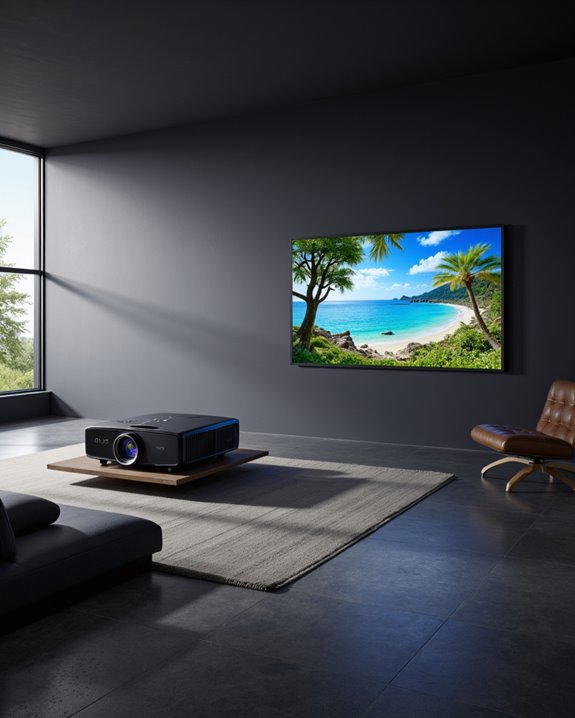
Comparing grey walls to professional projection screens reveals significant differences in performance and image quality across multiple factors. Professional screens offer superior material durability and color consistency, with surfaces specifically engineered for optimal light reflection and image clarity. While grey walls can provide adequate projection surfaces at a lower cost, they often lack the refined characteristics of dedicated screens. Professional screens utilize specialized coatings that provide superior ambient light rejection capabilities.
Key differences include:
- Professional screens deliver smoother surfaces, resulting in sharper images
- Dedicated screens maintain better viewing angles for group watching
- Grey walls may show texture imperfections that affect image quality
- Color accuracy tends to be higher on professional screens
- Professional screens offer consistent light distribution across the surface
The choice between a grey wall and professional screen ultimately depends on budget constraints and viewing requirements, with screens providing superior long-term performance.
Tips for Optimizing Your Grey Wall Setup
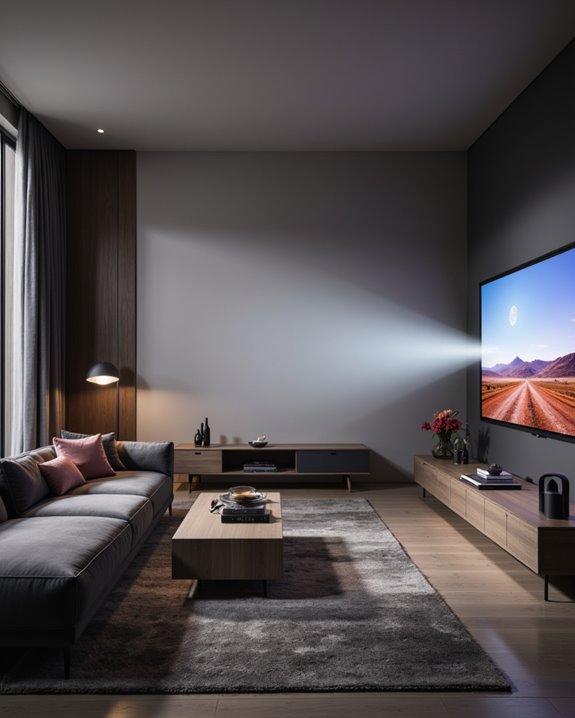
Setting up a projector on a grey wall requires careful attention to multiple factors for achieving the best possible image quality. Proper positioning of the projector ensures minimal distortion, while thorough wall texture preparation creates an ideal projection surface. The projector should be mounted parallel to the wall, with its lens centered for the clearest image. Screen size calculations should match your viewing distance by ensuring the screen width is roughly half the distance to your seating area.
Color calibration becomes essential when using grey walls, as the surface tone affects how colors appear on screen. Users should adjust brightness and contrast settings to compensate for the wall’s natural grey tone. Room lighting must be controlled through blackout curtains and strategic placement of light fixtures. Regular maintenance, including cleaning the wall surface and updating projector settings, helps maintain image quality over time. Secure mounting and proper cable management contribute to a stable, reliable setup.
Frequently Asked Questions
Can I Use Any Shade of Grey for Projection, or Is Specific Grey Recommended?
Specific grey wall shades designed for projection, like high-contrast CineGrey, are recommended over arbitrary grey tones. The paint finish must be smooth and matte to minimize light reflection and maintain image quality.
How Does Viewing Distance Affect Image Quality When Projecting on Grey Walls?
Like peering through tinted glass, viewing distance greatly impacts clarity. Closer distances reveal wall texture imperfections, while ideal viewing ranges depend on projection angle and screen size, affecting overall perceived sharpness and brightness.
Will Mounting the Projector at Different Angles Affect Performance on Grey Walls?
Mounting angles considerably impact projection performance, with non-perpendicular positioning causing uneven brightness and distortion. Wall texture can exacerbate these effects, making proper alignment especially critical for ideal image quality and contrast.
Does Room Temperature Impact Projection Quality on Grey Versus White Walls?
Room temperature has minimal direct impact on projection quality regardless of wall color. Temperature primarily affects the projector’s performance rather than how images appear on grey or white surfaces during operation.
Can Weatherproof Grey Paint Be Used for Outdoor Projection Setups?
Weatherproof grey paint is highly suitable for outdoor projection setups, offering enhanced grey wall durability against environmental elements. The specialized coating provides protection while maintaining ideal projection surface characteristics for exterior viewing conditions.

